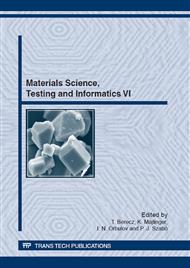[1]
J.V. Beck, B. Blackwell, C.R. St Clair Jr., Inverse Heat Conduction, Wiley, New York, (1985).
Google Scholar
[2]
A.N. Tikhonov, V.Y. Arsenin, Solution of Ill-posed Problems, Winston, Washington, DC, (1977).
Google Scholar
[3]
O.M. Alifanov, Inverse Heat Transfer Problems, Springer, Berlin/Heidelberg, (1994).
Google Scholar
[4]
M.N. Özisik, H.R.B. Orlande, Inverse Heat Transfer: Fundamentals and Applications, Taylor & Francis, New York, (2000).
Google Scholar
[5]
J.A. Nelder, R. Mead, A simplex method for function minimization, Comput. J. 7 (4) (1965) 308–313.
Google Scholar
[6]
J.C. Lagarias, J.A. Reeds, M.H. Wright, P.E. Wright, Convergence properties of the Nelder–Mead simplex method in low dimensions, SIAM J. Optimiz. 9 (1) (1996) 112–147.
DOI: 10.1137/s1052623496303470
Google Scholar
[7]
R. Das: A simplex search method for a conductive–convective fin with variable conductivity, International Journal of Heat and Mass Transfer 54 (2011) 5001–5009.
DOI: 10.1016/j.ijheatmasstransfer.2011.07.014
Google Scholar
[8]
O. Nelles, Nonlinear system identification, Springer-Verlag, Berlin, (2001).
Google Scholar
[9]
Fletcher, R. and Reeves C. M., Function Minimization by Conjugate Gradients, Computer J., 7, 149-1 54, (1964).
Google Scholar
[10]
K. Deb, A. Pratap, S. Agarwal, T. Meyarivan, A fast and elitist multiobjective genetic algorithm: NSGA-II, IEEE Transactions on Evolutionary Computation 6 (2) (2002) 182–197.
DOI: 10.1109/4235.996017
Google Scholar
[11]
K. Deb, Multi-objective Optimization Using Evolutionary Algorithms, Wiley, Chichester, UK, (2001).
Google Scholar
[12]
D.A.V. Veldhuizen, G.B. Lamont, Multi-objective evolutionary algorithms: analyzing the state-of-the-art, Evolutionary Computation 8 (2) (2000) 125–147.
DOI: 10.1162/106365600568158
Google Scholar
[13]
J. Clark and R. Tye: Thermophysical properties reference data for some key engineering alloys,. High temperatures – high pressures, Vol. 35/36, (2003/2004), pp.1-14.
DOI: 10.1068/htjr087
Google Scholar
[14]
A. Majorek, B. Scholtes, H. Müller, E. Macherauch: Influence of heat transfer on development of residual stresses in quenched steel cylinders, Steel research No. 4, (1994), pp.146-151.
DOI: 10.1002/srin.199400944
Google Scholar
[15]
H. M. Tensi, A. Stick : Martens hardening of steel - Prediction of temperature distribution and surface hardness, Materials Science Forum Vols. 102-104 (1992) pp.741-75.
DOI: 10.4028/www.scientific.net/msf.102-104.741
Google Scholar
[16]
I. Felde and T. Réti, Evaluation of Hardening Performance of Cooling Media by Using Inverse Heat Conduction Methods and Property Prediction, Journal of Mechanical Engineering, Vol. 56, (2010) Issue 2, pp.77-83.
DOI: 10.4028/www.scientific.net/msf.659.153
Google Scholar


